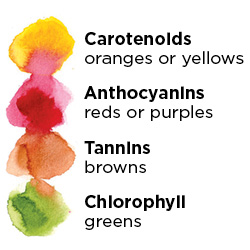Fetching Foliage
For a leaf, being green means being at work. Beginning in spring, when it first pushes out from a bud on a branch, a leaf is engaged in food production. The work is done within its cells where carbon dioxide from the air and water sent up from roots are turned into sugars in a sun-powered process called photosynthesis. For many of us, this was one of the first things we learned about plants in elementary school. Recall those illustrations of a plant in the sun, taking in carbon dioxide, giving off oxygen, and feeding itself in the process.
Key players in photosynthesis are plant pigments called chlorophyll. They collect photons — also known as light energy — which are then used to power the production of food. Chlorophyll is unable to absorb green light, so the color green is reflected back, giving foliage its familiar color.
Throughout the growing season, these pigments take a beating from the sun. Spent chlorophyll is regularly refreshed in order to keep photosynthesis going. At summer’s end, when temperatures cool and day lengths shorten, production of chlorophyll trails off. The lack of chlorophyll reveals a set of pigments that have been helping out with photosynthesis all along. Yet, being fewer in number, they have gone unseen.
 Some are carotenoids, pigments that give autumn leaves their orange and yellow colors. (If you’re picking up on the similarity to “carrot,” that is no coincidence; beta carotene is a type of carotenoid, as well.)
Some are carotenoids, pigments that give autumn leaves their orange and yellow colors. (If you’re picking up on the similarity to “carrot,” that is no coincidence; beta carotene is a type of carotenoid, as well.)
Shorter and cooler days signal additional changes in deciduous trees. Sugars are directed towards the roots, and the cells that make up sugar-transporting channels start to die. This process can trap sugars inside the leaf, which, in some species, synthesize into anthocyanins, pigments that are seen as shades of red and purple. The death of conducting cells where the leaf meets the branch eventually leads to leaf drop.
During the life of a leaf, waste products stored within cells are made up of compounds called tannins — the same that exists in grape skins (and stems and seeds), giving certain wines a more dry, astringent character than others.
They show up as a brown color when chlorophyll and other pigments fade away. The fading of chlorophyll and the presence of carotenoids, anthocyanins and tannins explains the wide array of colors that can be seen in the autumn foliage of deciduous trees.
Just how colorful this display is greatly depends on the species of plant. Compare the vibrant yellows of green ash (Fraxinus pennsylvanica) with the deep reds of Texas red oak (Quercus buckleyi). Genetics clearly play a role in fall color. However, environmental conditions such as temperature and rainfall influence fall color as well. Since annual conditions can vary so much, the autumn show of deciduous plants is not always the same — nor is it guaranteed to happen at all.
Red colors seem to be particularly fussy. Warm, sunny days and cool nights are key to their appearance. The production of chlorophyll tapers off quickly during cloudy or rainy days, making fewer sugars available for the production of anthocyanins (the red or purple pigments). And freezing temperatures damage plant cells, quickly putting an end to whatever brilliantly colored pigments the leaves had in them.
The timing of leaf drop in deciduous trees has long been a subject of scientific study. Tracking such things is especially important as the world’s climate is changing. When trees lose their leaves earlier or later than normal, a number of ecosystem functions can be affected, including carbon sequestration cycles and the composition of plant species growing in the understory.
Researchers at Boston University analyzed the findings of 64 different autumn leaf drop studies and found that, in response to increased temperatures, trees in the Northern Hemisphere are now losing their leaves later in the year. This is especially noticeable on trees in lower latitudes.
Whenever it occurs, the changing color of a leaf signals its death. Its work is finally done. The sugars it sent down to the roots will be used to build new leaves. A bud forms on the branch near the spot where the leaf once was. In this way, autumn colors are a celebration of what has passed and a sign of more to come.
Daniel Murphy is collections curator at Idaho Botanical Garden and founder of Awkward Botany, a weekly science blog. He specializes in native and waterwise plants and is working on a book about the world’s most hated plant group: weeds.

